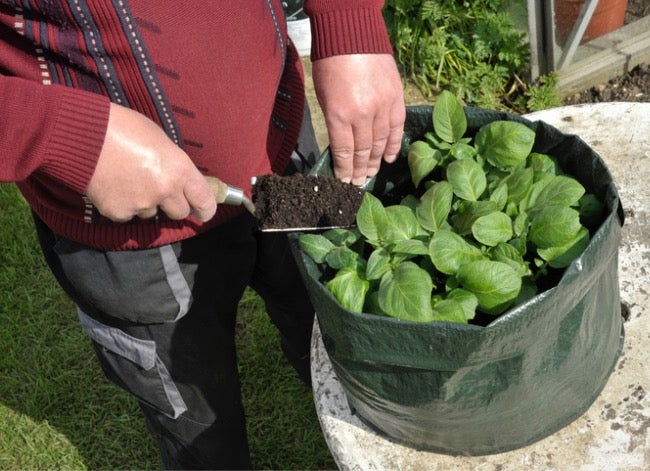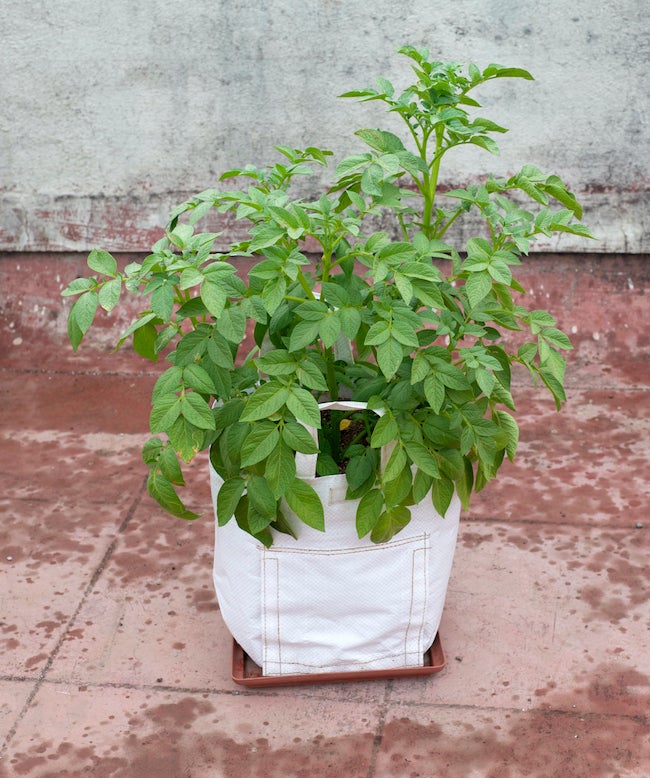Better Homes And Gardens Tote Bag Pattern
5 Important Things to Know About Gardening with Grow Bags
Do you need an easy way to raise vegetable or flower plants in a small space? It's in the bag!

istockphoto.com
Sewn from lightweight fabrics such as polypropylene or burlap, grow bags are soft, breathable versions of your favorite ceramic or plastic pots. The bags often have handles attached to make lifting them easier. They're lighter and airier than their clay counterparts, too. Those constructed simply of black plastic are considered inferior, since they don't "breathe" as well, so this article will concentrate on the porous fabric containers.
Available in a wide variety of shapes and sizes, grow bags are lighter than heavy terra cotta pots, so they don't require as much muscle for their maintenance. The bags' appearance, however, tends to be strictly utilitarian rather than decorative, which might make them more appropriate for vegetables than for flowers.
1. You don't need much space to garden with grow bags.
Even if you don't own acres of tillable land—or any land at all—you still can garden with grow bags tucked into corners of sunny balconies, porches, etc. A 5-gallon bag, which usually measures about 1 foot in diameter, can hold a single tomato plant, while a 3-gallon bag (about 10 inches across) will harbor one pepper plant or a "mess" of salad greens.

Photo: istockphoto.com
As for flowers, either of those containers will support at least three spreading annual plants such as petunias. You can double that amount for a small annual that doesn't spread as much, such as pansies.
Sometimes, storage space is at more of a premium than growing space. After the growing season, the emptied bags fold up for easy storage. Although the harvest from these containers won't be as impressive as that from larger gardens, these bags still can allow you and your children to experience and enjoy growing, pollination, and fruiting up close.
RELATED: The Best Grow Bags for Low-Maintenance Gardening
2. Plant selection is key.
For the best results, choose plants that have fairly shallow root systems such as brassicas, salad greens, radishes, etc. Those needing more "leg-room" or a bed in which to sprawl—think artichokes, asparaguses, lima beans, melons, parsnips, pumpkins, sweet potatoes, and winter squashes—aren't as likely to do well in grow bags unless those bags are very large.
Still, you often can find dwarf cultivars of such vegetables which are better suited for container growing. A few examples include cantaloupe 'Minnesota Midget,' pumpkin 'Jack Be Little,' and winter squash 'Jersey Golden Acorn.' However, if your grow bags receive less than 6 hours of sunlight per day, you probably should opt for either brassicas, root crops, or salad greens, which don't require as much light as tomatoes, peppers, and other sun-lovers do.

Photo: amazon.com
3. Grow bags have excellent aeration.
Grow bags have porous sides, so the roots growing inside them are "air-pruned" once they reach those sides, so they branch out rather than growing in a circle as they would in pots. Therefore, the plants in bags won't become root bound as those in hard pots can. That aeration also allows water to drain out from the sides as well as the bottom of the container, so that gardeners prone to overwatering aren't likely to cause root rot in their plants.
Flower fanciers in soggy climates can use grow bags to try plants that might previously have been impossible for them, such as African or alpine species. The raised soil of the grow bags and their built-in aeration can provide those plants the excellent drainage and water evaporation that they prefer.
RELATED: 19 "Zero Dollar" Garden Hacks
4. Plants in grow bags need more frequent watering.
Because grow bags are so well aerated, they dry out quickly once the plants they contain have grown large enough to fill them. So you'll probably need to water the bags at least once per day during the heat of summer.
You often can determine whether an extra watering is necessary by lifting one corner of the container. If the bag still feels heavy, the plants probably don't require any more water. If it feels light, however, they definitely could use a drink. You sometimes can slow down the rate at which the bags dry out by keeping them pushed close to each other.
Depending on where you set your grow bags, you also might need to provide trays to catch the water that drains out of them. Trays filled with gravel should work best, since grow bags are less prone to rot if they aren't sitting in water or on damp soil all the time.

istockphoto.com
5. Grow-bag plants need more frequent fertilization.
Plants grown in containers have a limited amount of soil from which to draw their nutrients, and those nutrients leach out due to frequent watering. As a result, plants in grow bags need more frequent fertilizing than garden plants do. If the potting soil you select already has slow-release fertilizer included in it, that should help. If not, you'll want to incorporate some, following the instructions on the fertilizer container.
Once you have planted your grow bag, you then can supplement the slow-release fertilizer with a liquid type. For fruiting vegetables, you might want to try a tomato plant food, mixed at half the strength indicated in the directions if applied weekly, or at full strength if only applied once every 2 weeks. When necessary, you also can use liquid kelp emulsion, diluted as per directions and sprayed directly onto the foliage, to green up plants quickly.
Better Homes And Gardens Tote Bag Pattern
Source: https://www.bobvila.com/articles/grow-bags/
Posted by: petersonagaisaink1965.blogspot.com

0 Response to "Better Homes And Gardens Tote Bag Pattern"
Post a Comment